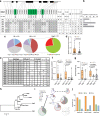Natural variation of DROT1 confers drought adaptation in upland rice
- PMID: 35871266
- PMCID: PMC9308802
- DOI: 10.1038/s41467-022-31844-w
Natural variation of DROT1 confers drought adaptation in upland rice
Abstract
Upland rice is a distinct ecotype that grows in aerobic environments and tolerates drought stress. However, the genetic basis of its drought resistance is unclear. Here, using an integrative approach combining a genome-wide association study with analyses of introgression lines and transcriptomic profiles, we identify a gene, DROUGHT1 (DROT1), encoding a COBRA-like protein that confers drought resistance in rice. DROT1 is specifically expressed in vascular bundles and is directly repressed by ERF3 and activated by ERF71, both drought-responsive transcription factors. DROT1 improves drought resistance by adjusting cell wall structure by increasing cellulose content and maintaining cellulose crystallinity. A C-to-T single-nucleotide variation in the promoter increases DROT1 expression and drought resistance in upland rice. The potential elite haplotype of DROT1 in upland rice could originate in wild rice (O. rufipogon) and may be beneficial for breeding upland rice varieties.
© 2022. The Author(s).
Conflict of interest statement
The protein sequence of DROT1 is the same as OsCOBL4, which has been granted patents in China (Z.L. 2013 1 0322634.4) and the United States (US 10, 190, 133, B2). For patent granted in China, the inventors are Z.L., H.X., P.L., J.L., H.Z. The title of the patent is “Plant drought resistance-related protein OsCOBL4 and its applications”. The invention provided a plant drought tolerance-related protein OsCOBL4 and its encoding gene and application. For patent granted in the United States, the list of inventors is Z.L., H.X., P.L., J.L., H.Z. The title of the patent is “Compositions and methods for improving abiotic stress tolerance”. The invention provided abiotic stress tolerant plants, as well as methods and compositions for identifying, selecting and/or generating abiotic stress tolerant plants. Other authors claim no competing interests.
Figures







References
Publication types
MeSH terms
Substances
LinkOut - more resources
Full Text Sources

